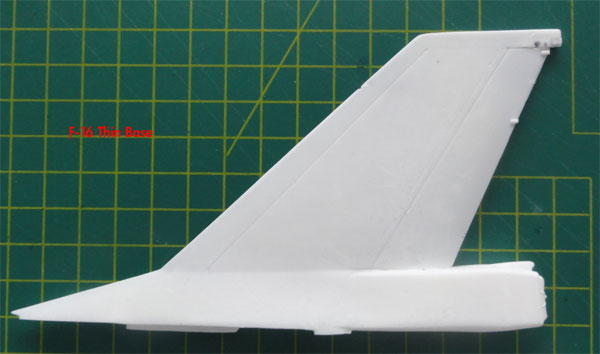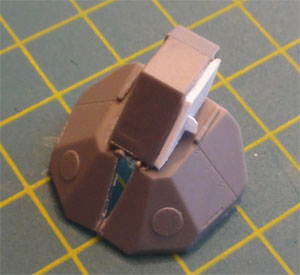Lockheed Martin F-16B Orange Jumper
[ Page B-3 ]
F-16B conversion of the SUFA Academy kit
... continued from F-16B page B2......
Steps 12-14
The gear assembly can be slightly improved.
First, reduce the beam part #D27 2 mm in length to get a correct setting of the forward gear nose leg. Academy provides 2 parts for choosing the nose gear door (#D77 / D76) but I could not see a difference. (note that the SUFA has different anti torque parts D31, D32). For the F-16B these seem OK to me.

The nose wheel leg hub on part D11 seems a bit different on the real F-16B. I recommend to ue nose wheel part D13 instead.
The nose gear bay and door seems OK with the typical lighter style lights (parts L15+D45). This is also appropriate for F-16 MLU types were the lights were placed on the nose gear door to avoid pilot blinding when using MLU night vision goggles. (so if you make a very early block F-16, do not fit these lights but set 2 different types of lights inside the main gear doors).
Step 13
Main gear leg
assembly seems OK to me. I am not sure if the legs should be thicker or
not for later heavier blocks; for the F-16B model, I simply used kit parts
as instructed.
Step 14
It seems that
Academy has changed in the F-16I SUFA kit the shape of the main
wheels (parts D7,D8,D9,D10) as compared to the similarly numbered wheel
parts on the F-16CJ kit. Also, for later heavier block F-16 planes, the
wheels may need a more accurate representation.
For this F-16B
model, I simply decided to stick to the supplied main wheel parts. But
if you have a spare set of main wheels from, say a Hasegawa 1/32 kit, use
these. These tyres look a bit thinner and better. Look how the F-16B wheels
look like here....

The main gear
doors were NOT bulged on earlier block F-16's like the F-16B. These are
not
included in either Academy kit.
Fortunately,
I have a couple of spare old Hasegawa kit
main doors, these were used. Strangely enough, they are 5 mm too short,
so some bended strip is still needed to lengthen these Hasegawa doors.

The door hinges
parts D21, D22,D23,D24 were used on the Hasegawa doors as well to have
additional details.

Step 15
Additional
fairings and adjusted air intake scoops are provided for the SUFA but are
not needed for the F-16B model. So the scoops (K7, K8, and K9,K10,K11,K12)
are not needed.
Step 16
The instructions
show the F-100 engine exhaust. This is OK for the F-16B. (Please note that
for the F-16I SUFA, the exhaust is not 100% correct as the SUFA has block
52+ PW229 engines).
But for the F-16B no problem, assemble as shown. On the exhaust panels, decals numbered #K67 could be applied after painting the exhaust.
Step 17
The extra etched
metal parts are not required for the F-16B. So no cut-off or modification
needed at the arrestor hook area.
The airbrakes are OK, but were selected "closed" for this model; if you want to display them open, add a couple of very tiny spring doors at the hinge base from thin card.
(Steps 18-19 wing assembly was tackled before).
Step 20
Assemble the
trailing edge flaps as shown. Some putty is needed here at the lower gap.

Step 21
The vertical tail with the thin base
of the F-16B was already converted
and tackled as seen here. It is now time to fit this vertical tail.
It is highly recommended to use metal pins here to get a strong joint.
Now fill in the remaining gaps and sand in shape.
As maybe I want to make in the future
another number of early block F-16 models, I made a rubber mould for the
thin base vertical tail and with resin poured this vertical tail:

On the parachute housing fairing, some small additional fairings are still to be set, using thick pieces of plastic rod sanded in shape. These fairings depend on the air force.
Step 22
The radar is usable from the Academy F-16CG/CJ kit. The nose radar cone is
now 2 parts but almost 95% identical as on the Academy F-16CG/CJ kit. The
metal pitot tube attachment base is a bit different with very tiny differences
in the anti-lightning lines. For my F-16B model, the radar was not further
assembled, only a clean nose. The metal parts in the kit are a nice touch.
Step 23
The instrument
cover part K67 is new and looks much better than part C57 on the older
kit.
The HUD looks
similar as in the Academy F-16CG/CJ kit. The central cover part
K68 unfortunately not wide enough at the top, so this was corrected by
cutting a slot and bending the part. The top-housing was made thicker with
a piece of card.
 ..
..
and sprayed black...

Step 24
2 two seater
canopies are provided, a very nice feature: tinted "gold / smoke" or clear.
The small kink in the canopy base (part K3) is very well done (this was
an important error in the resin ISRACAST two seater conversion set, which
missed this kink shape).
You will need to sand and polish the mid moulding ridge in the center. I was not able to get it completely polished smooth to be "unseen" however' ; some distortion is inside the transparent plastic.

The canopy frame has some gaps, fill
these as seen here:

For the F-16 MLU, like the F-16B
MLU, night vision goggle sensors should be added from thin plastic strip.
Look
here for a
picture....

For the F-16B, parts M18 and M19 are not needed. I suggest to use parts D49 for the F-16B MLU.
Step 25
The ladder
is a very nice feature but as in Academy F-16CG/CJ kit .
Step 26
The antenna
parts D72 look OK as well for the F-16B MLU. For early block F-16 planes,
do not fix these antennas.
The remainder SUFA antennas and ECM fairings like the ASPJ antenna are not needed for the F-16B. For the F-16B fix the anti-collision lights parts G10 still found on the sprues, as well as the pitot tube D47.
Step 27
The missile
launchers are good. Also you get the wing tip lights but with smoke colour.
As noted, the static dischargers #B13 were replaced with thin wire and
their bases made from a drop of white glue.
Now I fitted
the re-enforcement plates at the upper fuselage that were later
MLU modifications including on the F-16B of the Dutch AF. I simple used
the pattern seen here and cut these panels from thick tape. The
tape was cut in shape with a very sharp scalpel knife and than added on
each surface as required.
Look here at the Dutch
IPMS site for the shape of these re-enforcements plates.

NOTE: early
F-16's before and up to block 30 like this Dutch AF F-16B has at the slat
at the inboard position only "2" slat rotating fingers". Later block beyond
block 30 F-16 have "3" fingers. Probably this is modification applied
later to cope with more stress. As the newer Academy F-16I is used, one
"finger" should be filled with some putty.

Also note that
the panels at the aft spine are a bit different as noted here. The black
circle should be inscribed and the rest filled and sanded.
and the result....
 ..
..
and the tailbase (note that the additional
parapack side fairings are still to be added for this particular F-16B of
the RNeth Air Force)

For the lower grey Fed.Std. 36375
I used acrylic paint Mr.Color/Gunze Sangyo H308

and the upper area....

The correct Fed.Std. top coats are
still to be sprayed on. The next step is to add the detail parts.
On to next [ page B4.... ]

(c) Copyright "designer"/ All rights reserved. Your comments are welcomed by webmaster
Created this page
December 18, 2010